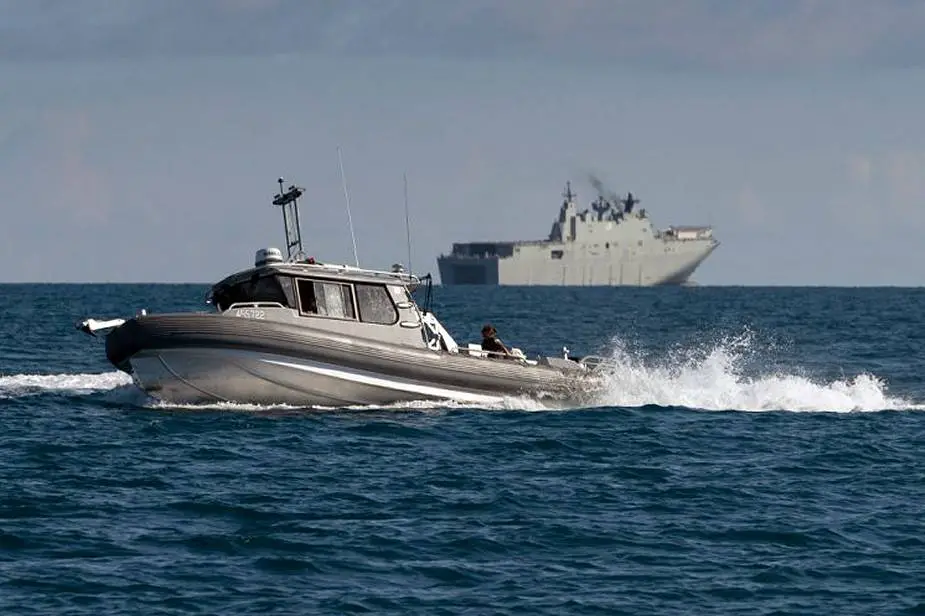According to information published by the Australian Navy on November 8, 2020, the Australian Navy’s Maritime Geospatial Warfare Unit has deployed a new type of small survey craft from HMAS Adelaide (L01) Landing Helicopter Dock (LHD) for the first time. Called ‘Polaris’, the survey craft was first launched and recovered from Adelaide during amphibious training off the coast of Queensland near Townsville during Exercise SEA WADER.
Follow Navy Recognition on Google News at this link
 Survey Boat 'Polaris' conducts maneuvers at high speed with HMAS Adelaide in the background during Exercise SEA WADER 2020. (Picture source Australian Navy)
Survey Boat 'Polaris' conducts maneuvers at high speed with HMAS Adelaide in the background during Exercise SEA WADER 2020. (Picture source Australian Navy)
The vessel is part of a range of new capabilities, including a Fly Away Survey Kit and the Remus 100S Autonomous Underwater Vehicle (AUV), that aim to modernize the collection and processing of geospatial data by Navy Hydrographers.
Operations Officer Maritime Geospatial Warfare Unit, Lieutenant Commander Paul Clark, said the team in Adelaide had been able to develop and test the procedures for launching the survey vessel from the LHD platform.
Navy’s Hydrographic, Meteorological and Oceanographic Group has four Deployable Geospatial Survey teams that have been undergoing training for the past 12 months on the various capabilities that will be delivered under the SEA 1770 project.
The new survey vessel will provide the geospatial survey teams a new approach to Rapid Environmental Assessment and allow them to provide products to support military operations, including Humanitarian Aid and Disaster Response (HADR).
The vessel is equipped with a range of geospatial technologies including a multi-beam echo sounder, side-scan sonar, sub-bottom profiler and the ability to deploy its own AUV.
HMAS Adelaide (L01) is the second of two Canberra-class landing helicopter dock (LHD) ships of the Royal Australian Navy. She is the second of two Canberra-class landing helicopter dock (LHD) ships of the Royal Australian Navy (RAN). The ship was laid down in February 2011 and launched on 4 July 2012. The largest ships ever built for the Royal Australian Navy (RAN), the Amphibious Assault Ships are also known as Landing Helicopter Docks (LHD) were built by contractors BAE Systems Australia and Navantia.
The LHDs are able to transport 1,046 soldiers and their equipment. Adelaide will be capable of deploying a reinforced company of up to 220 soldiers at a time by airlift.[4] Two vehicle decks (one for light vehicles, the other for heavy vehicles and tanks) have areas of 1,880 square meters (20,200 sq ft) and 1,410 square meters (15,200 sq ft) respectively, and between them can accommodate up to 110 vehicles. The well deck will carry up to four LHD Landing Craft, which can be launched and recovered in conditions up to Sea State 4. The flight deck can operate six MRH-90-size helicopters or four Chinook-size helicopters simultaneously, in conditions up to Sea State 5. A mix of MRH-90 transport helicopters and S-70B Seahawk anti-submarine helicopters will be carried: up to eight can be stored in the hangar deck, and the light vehicle deck can be repurposed to fit another ten.
The Canberra-class vessels are 230.82 meters (757.3 ft) long overall, with a maximum beam of 32 meters (105 ft), and a maximum draught of 7.08 meters (23.2 ft). At full load, Adelaide will displace 27,500 tonnes (27,100 long tons; 30,300 short tons), making the Canberra-class ships the largest vessels to serve in the RAN.[5] Propulsion is provided by two Navantia Siemens 11-megawatt (15,000 hp) azimuth thrusters, each with an onboard electric motor, driving two 4.5-meter (15 ft) diameter propellers.



